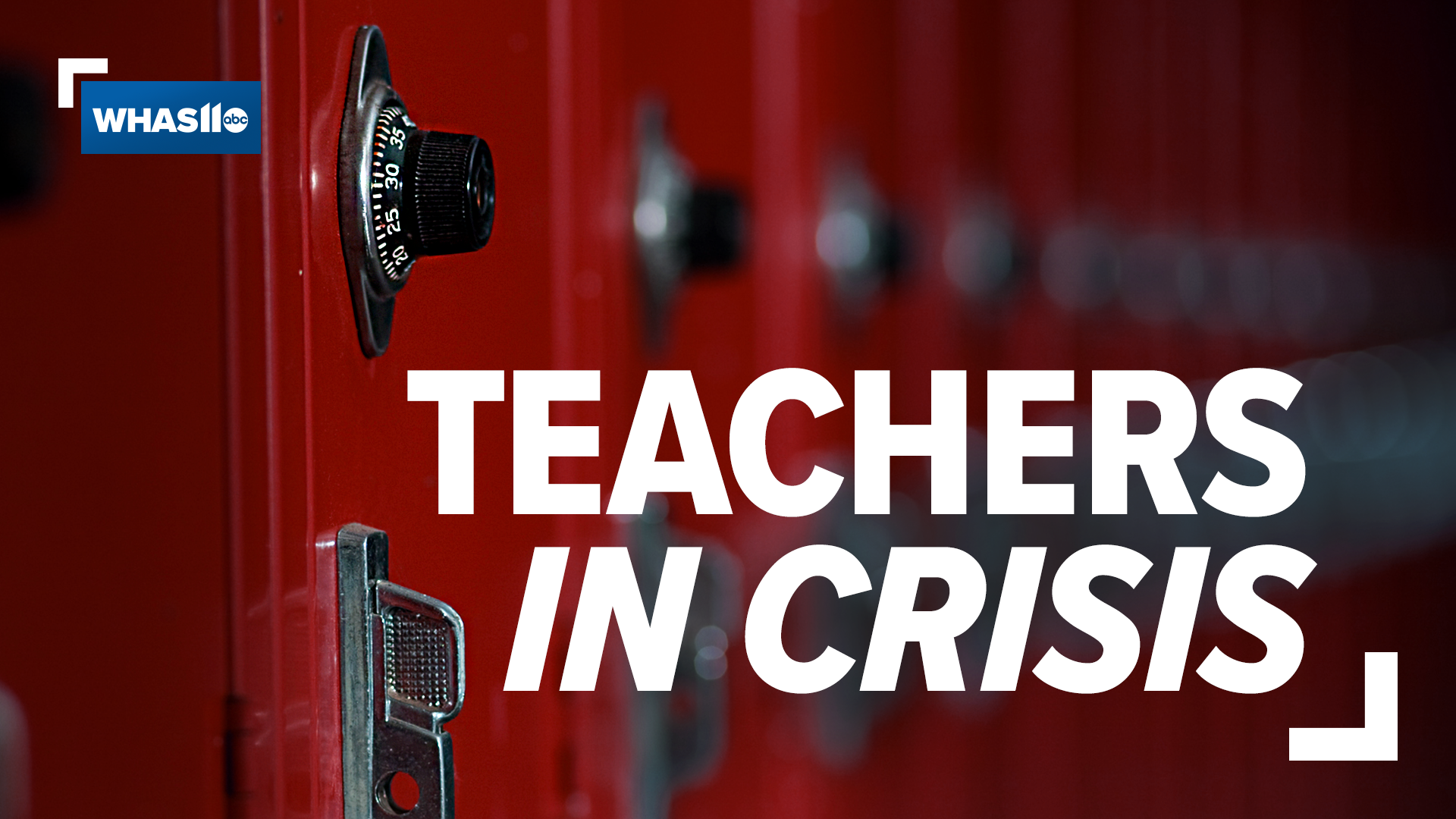LOUISVILLE, Ky. — Teachers in the United States are in a crisis. They are fighting battles both inside the classroom and at the national level, and many are leaving the profession altogether. Research shows close to 10% of teachers pack up their desks for good every year, and two-thirds of those teachers leave for reasons other than retirement. On top of that, fewer college students are choosing to take the path to education.
We wanted to find out why this decline is happening – and what we can do to stop it.
Do you have a story about a great teacher in your life? Send us a message on Facebook or email us at web@whas11.com.
What’s happening?
According to a report by the Economic Policy Institute, the United States is short about 110,000 teachers, and that number is expected to double by 2025.
Thousands of teachers were laid off during the Great Recession. Since then, schools have bounced back, but teachers haven’t. There are more students in school than ever before, and districts are bringing back classes and programs that were cut during the recession. However, there just aren't enough qualified teachers to supply the demand and a decline in college enrollments in this field isn’t helping.
According to the EPI, 37% fewer students enrolled in teacher education programs from 2009 to 2015. That’s a decrease of almost 240,000 professionals on their way to the classroom.
UofL is hoping to change the pattern
The University of Louisville is experiencing a similar trend. In 2016, the university had over 2,200 full-time education majors. For the 2019-2020 school year, enrollment dropped by 400.
UofL professors are trying to create incentives to get more students in education programs. It's working with local school districts to identify high school students who may be a good fit for education, and giving them opportunities to earn college credit hours before they ever set foot on a college campus. This is saving them both time and money.
“We want them to choose teaching, of course, but it’s not the profession for everyone and it’s important they make an informed choice,” said Betty Doyle, a clinical instructor at the UofL College of Education. “We’re infusing that more and more into our preparation program. Because we see the need. We’re hearing that from our former graduates.”


Students currently in the program at UofL show that the passion for teaching is still alive.
“Growing up as a student, I didn’t have the best time in the public schooling system, so I want to fix it,” said freshman Elisha Calhoun. “I’m not a big fan of giving up on ones who need you the most.”
“The feeling you get when you see a kid grasp onto a new concept is unbeatable. Knowing you’re making an impact on kid’s life and changing the future is what I want to do,” freshman Carson Tuscany said.
The first years are the hardest
Close to 30% of new teachers will quit teaching within the first five years. Since 1989, the rate of teachers leaving has continued to rise. Sydney Becker is a first-year teacher at Fern Creek High School. She is trying to break the curse of her classroom, which became known as a “revolving door” after three teachers came and went during the previous school year.
“I was warned of [the] worst-case scenario,” she said.
The latest research from the Learning Policy Institute shows the percentage of all teachers in the United States who leave their profession in a given year is double that of other high-achieving areas like Finland, Singapore and Ontario, Canada, where the rate stands closer to 4%. This rate is even higher for teachers who have less than 5 years of experience.


Low wages, disrespect, and opportunities in other fields are driving teachers out of their jobs and into other careers. Turnover rates are especially high in low-income schools and schools with large concentrations of students of color.
"If you're doing what you're asked to do as a teacher, you're emotionally available for your students, which goes from everything like being transparent about yourself...to talking with them about how they're living in a homeless shelter because their mom kicked them out or their parents don't feed them, Becker said. "So you're wondering to yourself, can I give this student money to pay for a meal?"
Becker hopes that she can be a source of stability for her students, especially for the ones who don’t get the attention they need at home. She wants them to know that she’s in this for the long haul.
“My students by far are the greatest joy of everything. There are hard days for sure, but they make this job enjoyable. They make it fun.”
Why is this happening?
Underpaid and underfunded
The starting salary for teachers in Kentucky is $36,752, just under the $37,000 of student loan debt the average American owes after graduation. Indiana teachers begin their careers making around $35,943 on average.

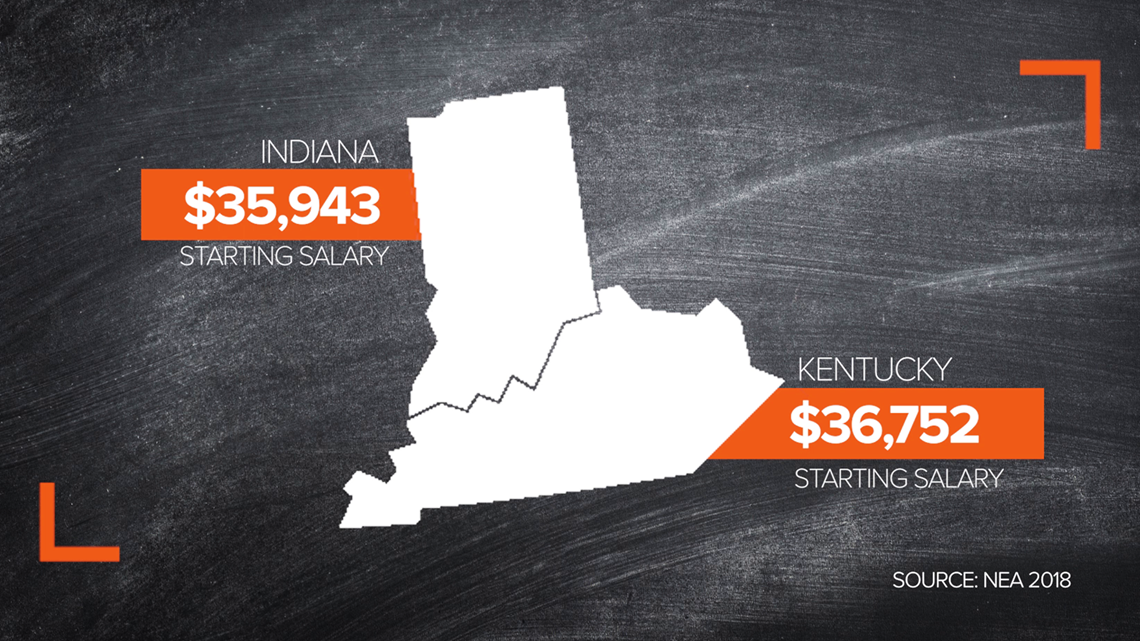
The U.S. average public school teacher salary for 2018–19 was estimated to be $61,730, according to the National Education Association. Teachers in Kentuckiana fall well below that on the pay scale.
Average teacher salary in Kentucky: $53,923
Average teacher salary in Indiana: $50,614
Teachers will tell you their salaries aren’t the focus of recent rallies at state capitols across the country. Indianapolis and Frankfort became local hubs for the ‘Red for Ed’ and #120Strong movements in 2019, leading to ‘sickouts’ and missed school days for hundreds of thousands of students.

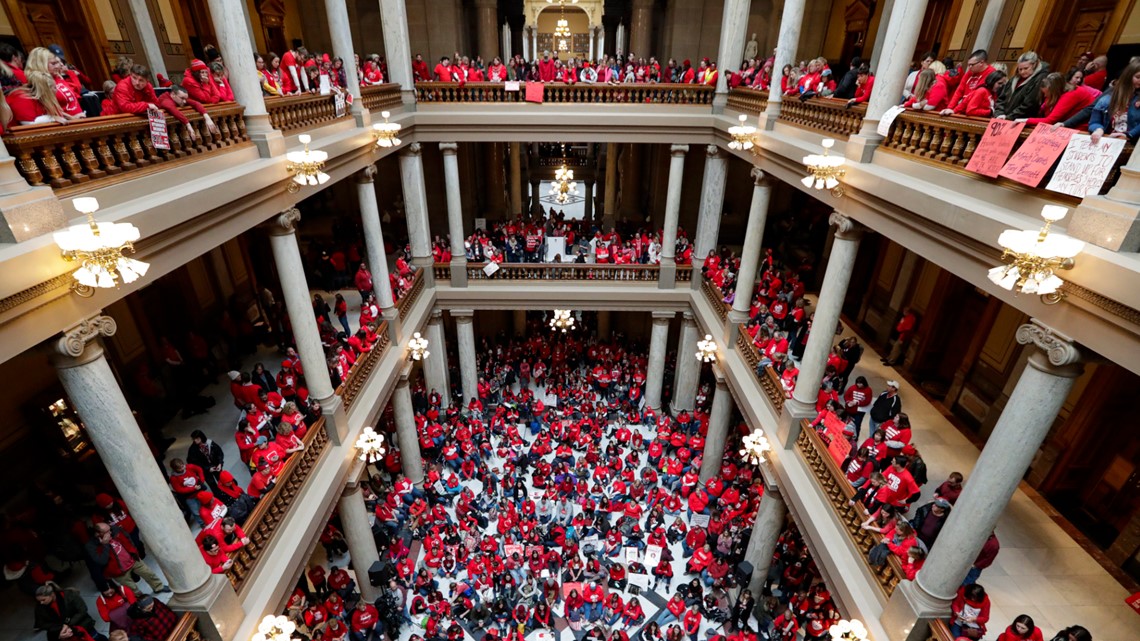
Teacher pensions remain on the line, salaries are at stake as districts work to understand and implement new standardized testing requirements and prep tests. State funding for classrooms has also decreased considerably, about 15%, over the last decade when considering inflation.
These factors are driving thousands from their classrooms every year.
“If I can teach high school math or be a mechanical engineer, some individuals may say, ‘Well, in mechanical engineering I can make ‘X amount’ more dollars than just as a high school teacher,’” said Amy Lingo, the Interim Dean at the UofL College of Education and Human Development. Nationwide, teacher salaries are down 4.5% over the past decade when adjusted for inflation, according to the NEA.
Aside from salaries, the decrease in state funding is forcing districts to scale back on educational services, including supplies and classroom resources.
“Every teacher knows the difference between a government-funded classroom versus a teacher-funded classroom,” said Miranda Schwartz, who teaches Pre-K at S. Ellen Jones Elementary in New Albany. “Like most teachers, I just end up buying for my students and for my classroom without thinking about it.”

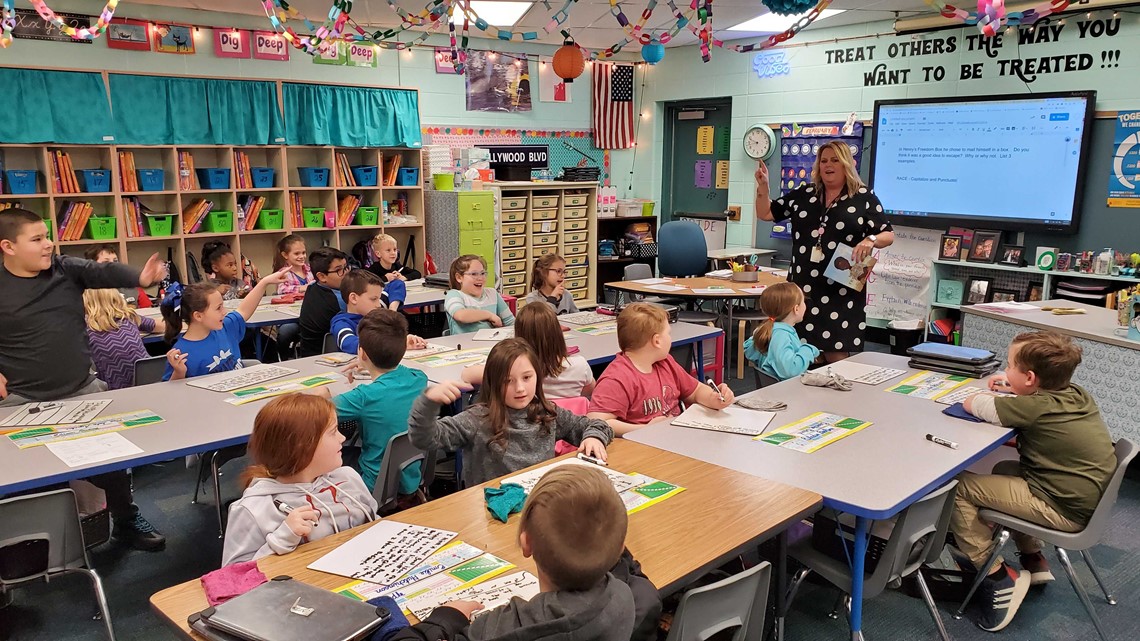
Teachers told WHAS11 they’ll spend anywhere from $1,000 to $2,500 on their classroom each year. Cristie Haire, a 3rd grade teacher at Jonathan Jennings Elementary in Charlestown, Indiana, said she spends about $1,000 at the start of the year. She loses count by the end but says it’s about more than just meeting basic needs.
“I choose to spend that money...I want kids, when they walk in here to be like, ‘This is a nice place. This is a place where I feel safe. I feel loved,’” she said.
Their out-of-pocket expenses go far beyond pens and notebooks. For the 2018-2019 school year, nearly three-quarters of students enrolled in Kentucky schools were eligible for free or reduced meals. The most recent data from the Indiana Department of Education said nearly half of the students in the New Albany and Greater Clark school systems qualified.

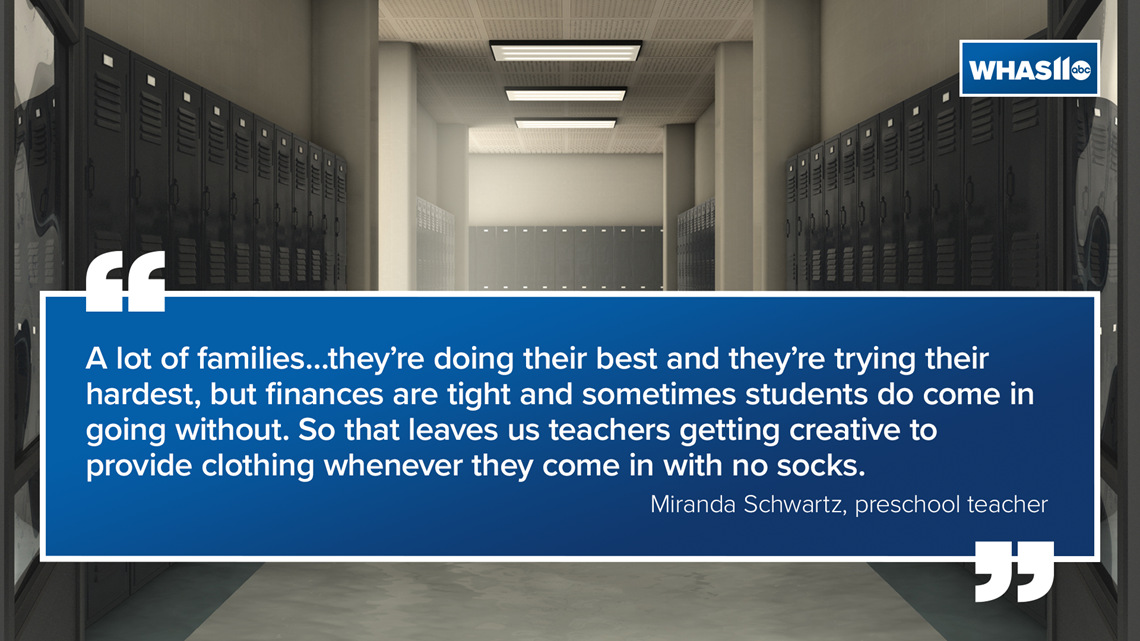
When their students go without, teachers will fill the void.
“You know, we are their home, we are their provider. So, we are giving them the supplies they need, we’re giving them snacks, we’re giving them food, we’re buying them coats, we’re buying them shoes – things they’re not getting at home,” Haire said.
While there was an increase in funding over the last year, pensions are still only 58.1% funded for teachers in Kentucky, far from a passing grade.
“My hope is that the money is there,” Haire said. “I hope that people in the state and the powers that be handle that money respectfully, with fidelity, to make sure that what we were promised and worked so hard for is what we come up with at the end.”
Kentucky Governor Andy Beshear campaigned hard on a pro-teacher platform in 2019 and defeated former Governor Matt Bevin. Beshear’s proposed budget for this year includes a $2,000 salary raise for teachers and fully funds the teacher requirement system. There are questions about how the state will fund this.
“With these investments in public education, both K through 12 and post-secondary, we are showing that, in Kentucky, education comes first,” Beshear said in his budget address in January.
Indiana teachers will have to wait for a pay boost. While the state increased spending on education in 2019, none went toward teacher salaries. Governor Eric Holcomb is waiting one more year before providing additional funds toward teacher pay and pensions. For the 2021 budget, he has promised $250 million for teacher retirement and $50 million for teacher pay.
The stresses of standardized testing
While the issue of funding is massive, teachers also say the requirements and prep work for standardized tests are unrealistic and not supported by additional funds.
In Indiana, school districts and legislators are working to change how the state’s new ILEARN test affects school funding and teacher pay. In its first year, the state hit a new low for grades, angering parents and school leaders. Educators say the new exam is more complicated, longer and more difficult than the previous exam, and nearly two-thirds of Indiana students did not pass the test. Teachers are concerned these poor test scores will be used to evaluate their performance - and their salaries.
In Kentucky, current legislation could dramatically change the newest graduation requirements for high schoolers, who must earn a minimum score on state tests in reading and math. If a school tests poorly, “principals could lose their jobs. Teachers could get a cut in salary and schools could lose autonomy,” JCTA President Brent McKim said. If Senate Bill 158 passes, “it would help,” McKim said.
Universities across the country are considering making SAT and ACT test scores optional for undergraduate applications. Bellarmine University in Louisville decided to make the change for the 2021 school year, choosing to focus on high school grades and leadership experience rather than test scores. Indiana University is also considering the change. According to a Jan. 2020 study by the American Educational Research Association, a high school GPA was a better indicator of whether a student would graduate from college than that student’s ACT score.
Behavior and discipline in the classroom
“I think what I face most consistently and what a lot of teachers at my school face most consistently is an absolute disrespect for authority,” Sydney Becker said.
Student behavior and disrespect is a major factor for teachers who are choosing to leave their careers.
Phone usage in the classroom is a constant obstacle. While many schools have no-phone policies, those rules can be difficult to enforce when an entire class chooses to scroll Twitter rather than pay attention.
"Sometimes it's worth the fight and other times it's not," Becker said.
In a 2014 Harris Poll, only 31% of the adults surveyed felt like students respected their teachers. Becker said that when it comes to discipline, there isn't much she can do.
"There's referrals, which kids have told me to my face is just a piece of paper," she said. "They'll call their mom and hand the phone to me and say, 'Go ahead, call her.'"


When these behavior issues escalate, social media can quickly turn a fight into a viral sensation.
“It’s personally sad to me that kids think it’s better to stand and record a fight than to help end a fight,” said Valerie Jillson, an English teacher at Central High School in Louisville.
During the 2018-19 school year, there were nearly 300,000 “behavior incidents” reported in Kentucky schools. More than 5,000 of those incidents included assault or violence. In the last three months, three different Lousiville high schools made headlines because of violent incidents.
Omar Morris, a counselor at Barrett Traditional Middle School, said social media is part of the problem.
"Whenever we were growing up, whatever happened at school with another student stayed at school until at least the next day," he said. "Now, with social media, it can continue...We’re seeing an increased level of anxiety with our young people and I know one of those reasons is what’s happening with social media."


Beyond the day-to-day incidents, the threat of a potential school shooting is often on teachers’ minds. In 2019, 8 people were killed and 43 were injured in 25 school shooting incidents in the United States, according to EdWeek.org.
“I feel helpless. You can do all the training you want to, but on a lockdown…you have no idea what’s going on,” Becker said.
Today, active shooter drills happen almost as frequently as fire and tornado drills.
"That’s the world we live in," Jillson said.
States are actively working to improve safety in schools. A bill currently in the Kentucky legislature would arm School Resource Officers in schools and Jefferson County Public Schools is working to develop its own security force.
JCPS is also working to improve student behavior and reduce suspensions by expanding restorative practices district-wide. The district introduced the concept in 2016 and there are currently 30 schools using positive behavior interventions.
For now, Jillson hopes people will take what they see on the news - and on their newsfeeds – with a grain of salt as teachers work to maintain control of their classrooms.
“There’s a context to what caused this to happen and judgment should be repelled until the context is understood,” she said.
Misconceptions
Teachers aren’t just feeling a lack of support inside the classroom. There are many misconceptions about the teaching industry and some teachers feel like they are looked down upon by their peers.
“We’re not treated as professionals. I mean, that is the one thing,” said Kimberly McClure, a math coach at S. Ellen Jones Elementary in Indiana. “I think we need to get communities and we need to get societies to start saying, ‘Oh my gosh, being a teacher is amazing.’”

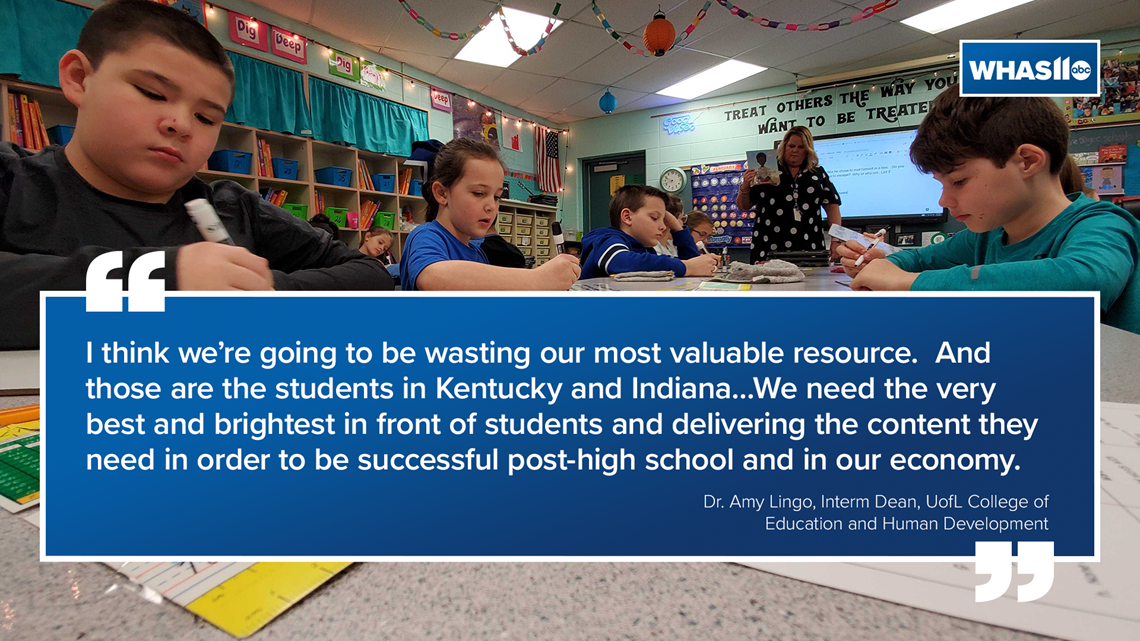
A teacher’s work schedule is often called into question. While the students leave after the final bell, a teacher’s work is far from over then.
“This is not your 9 to 5 job or your 7 a.m. to 2:20 p.m. It’s a constant job that you’re always thinking about,” Sydney Becker said.
Some teachers who speak out about their workload are criticized by others because they “get summers off.” Those teachers will be quick to tell you that they aren’t spending their summers lounging out by the pool. Instead, they’re planning lessons, prepping their classroom, and spending their own money to attend conferences so they can improve the lives of their students in the next school year.
RELATED: A teacher told her she wouldn’t amount to anything. She became a teacher to prove her wrong
“Do we really get those breaks? Not if you’re in it for the right reason,” McClure said. “I can’t say for all teachers, but if you’re in the job for the right reason, you don’t get breaks. You’re doing anything you can to get better.”
How can I help?
If you are a parent or a peer and you feel a desire to help your local teachers, there are ways you can do that. PTO groups will often collect donations for supplies, and local nonprofits offer grants to help with field trips and equipment.
On a larger scale, the situation our teachers are in won’t change unless those in charge of funding education take action.
“We have to do more. Our state governments and our federal government need to provide more to our schools and to our teachers so that we can fully fund all of our classrooms,” Miranda Schwartz said.
RELATED: 3 simple ways you can help a teacher
The one thing anyone can do to help teachers is a simple one. Tell them "thank you." Tell them that they are appreciated. Tell them that they are doing a good job.
For many, being a teacher is a thankless job. It’s exhausting, draining, and overwhelming. They act not only as educators, but also as counselors, social workers, and friends for their students. It’s a big job, but someone has to do it.
“Tradition says education isn’t important. Teachers aren’t important. Which is insane to me because these kids are our future. What is more important than kids and our future? We’ve got to give them the tools they need. And if it’s not teachers, who is it going to be?” Cristie Haire said.
Contact reporter Rob Harris at rjharris@whas11.com. Follow him on Twitter (@robharristv) and Facebook.
Contact reporter Brooke Hasch at bhasch@whas11.com. Follow her on Twitter (@WHAS11Hasch) and Facebook.
---
Make it easy to keep up-to-date with more stories like this. Download the WHAS11 News app now. For Apple or Android users.
Have a news tip? Email assign@whas11.com, visit our Facebook page or Twitter feed.

